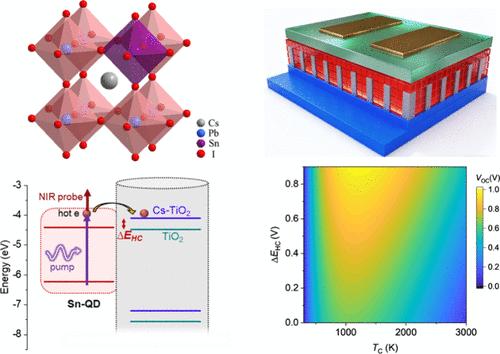Hot-Electron Extraction from Perovskite Quantum Dots for Photovoltage Enhancement
IF 18.2
1区 材料科学
Q1 CHEMISTRY, PHYSICAL
引用次数: 0
Abstract
Rapid energy loss from hot-carrier relaxation above the bandgap limits optoelectronic efficiency. A key unmet challenge for hot-carrier utilization is developing practical systems that combine long hot-carrier lifetimes in absorbers with efficient extraction in devices. Here, we fabricate CsPb1–xSnxI3 perovskite quantum dots (QDs) with long hot-carrier lifetimes under low pump intensity─critical for real applications. We also design Cs-doped TiO2 nanorod arrays as hot-carrier high-pass filters; their tuned band structure enables around 82% hot-electron extraction from surface-sensitized QDs, confirmed by visible/near-IR transient absorption and supported by DFT/NAMD calculations. Proof-of-concept hot-carrier solar cells based on these QDs-sensitized nanorod arrays show a 12% open-circuit voltage increase (up to 1.13 eV) vs normal cells, attributed to hot-carrier photocurrent (73% quantum efficiency at 400 nm vs 600 nm). Hot-carrier thermionic emission modeling validates results, providing a promising platform for photovoltaics beyond the Shockley–Queisser limit.

钙钛矿量子点的热电子萃取用于光电压增强
热载流子在带隙以上弛豫造成的快速能量损失限制了光电效率。热载流子利用的一个关键挑战是开发实用的系统,将吸收器中的长热载流子寿命与设备中的高效萃取结合起来。在这里,我们在低泵浦强度下制造了具有长热载子寿命的CsPb1-xSnxI3钙钛矿量子点(QDs),这对实际应用至关重要。我们还设计了碳掺杂TiO2纳米棒阵列作为热载子高通滤波器;它们的调谐能带结构可以从表面敏化的量子点中提取约82%的热电子,由可见/近红外瞬态吸收证实,并得到DFT/NAMD计算的支持。基于这些qds敏化纳米棒阵列的概念验证热载子太阳能电池显示,与普通电池相比,热载子光电流的开路电压增加了12%(高达1.13 eV)(在400 nm比600 nm处的量子效率为73%)。热载流子热离子发射模型验证了结果,为超越Shockley-Queisser极限的光伏发电提供了一个有前途的平台。
本文章由计算机程序翻译,如有差异,请以英文原文为准。
求助全文
约1分钟内获得全文
求助全文
来源期刊

ACS Energy Letters
Energy-Renewable Energy, Sustainability and the Environment
CiteScore
31.20
自引率
5.00%
发文量
469
审稿时长
1 months
期刊介绍:
ACS Energy Letters is a monthly journal that publishes papers reporting new scientific advances in energy research. The journal focuses on topics that are of interest to scientists working in the fundamental and applied sciences. Rapid publication is a central criterion for acceptance, and the journal is known for its quick publication times, with an average of 4-6 weeks from submission to web publication in As Soon As Publishable format.
ACS Energy Letters is ranked as the number one journal in the Web of Science Electrochemistry category. It also ranks within the top 10 journals for Physical Chemistry, Energy & Fuels, and Nanoscience & Nanotechnology.
The journal offers several types of articles, including Letters, Energy Express, Perspectives, Reviews, Editorials, Viewpoints and Energy Focus. Additionally, authors have the option to submit videos that summarize or support the information presented in a Perspective or Review article, which can be highlighted on the journal's website. ACS Energy Letters is abstracted and indexed in Chemical Abstracts Service/SciFinder, EBSCO-summon, PubMed, Web of Science, Scopus and Portico.
 求助内容:
求助内容: 应助结果提醒方式:
应助结果提醒方式:


